Also available in: Deutsch
Chinatown in Bangkok is one of the most fascinating neighborhoods, offering a unique insight into Chinese culture and history in Thailand. Its origins date back to the 18th century, and over time, Chinatown has evolved into a significant cultural and economic hub. This vibrant district, also known as Yaowarat, stretches along the eponymous Yaowarat Road. It is one of the oldest neighborhoods in the Thai capital.
Highlights and Tips in Bangkok’s Chinatown
- Accommodation in Bangkok – our hotel tip
- 1. Wat Traimit
- 2. Sampaeng Lane
- 3. Wat Chakrawatrachawat Woramahawihan
- 4. Chinatown Gate
- 5. Yaowarat Road
- 6. Sky View 360 at Grand China Hotel
- 7. Wat Mangkon Kamalawat
- 8. View from the River View Residence
- 9. Talad Noi Streetart
- 10. So Heng Thai Villa
- 11. Sala Chalermkrung Royal Theatre
- 12. Wat Samphanthawongsaram Worawihanra
- 13. Ong Ang Walking Street
- 14. Experience Street Food in Chinatown
- Bangkok Chinatown: Tours and Tickets
- How to Get to Bangkok
In this article, we’ll share our tips for exploring Bangkok’s Chinatown. From markets, street art and, temples, to impressive views, the neighborhood offers plenty of diversity during your exploration. It’s a great contrast between modernity and tradition and, for us, one of the neighborhoods you should definitely not miss in Bangkok.
Accommodation in Bangkok – our hotel tip
The Chatrium Riverside Hotel is located right on the banks of the Chao Phraya River and is one of our favorites. It offers top-notch rooms and suites with balconies and views of the city or the river. Additional highlights include a swimming pool, a spa, a modern fitness center, and two restaurants. You will definitely feel comfortable here and enjoy a relaxing stay in the vibrant city.
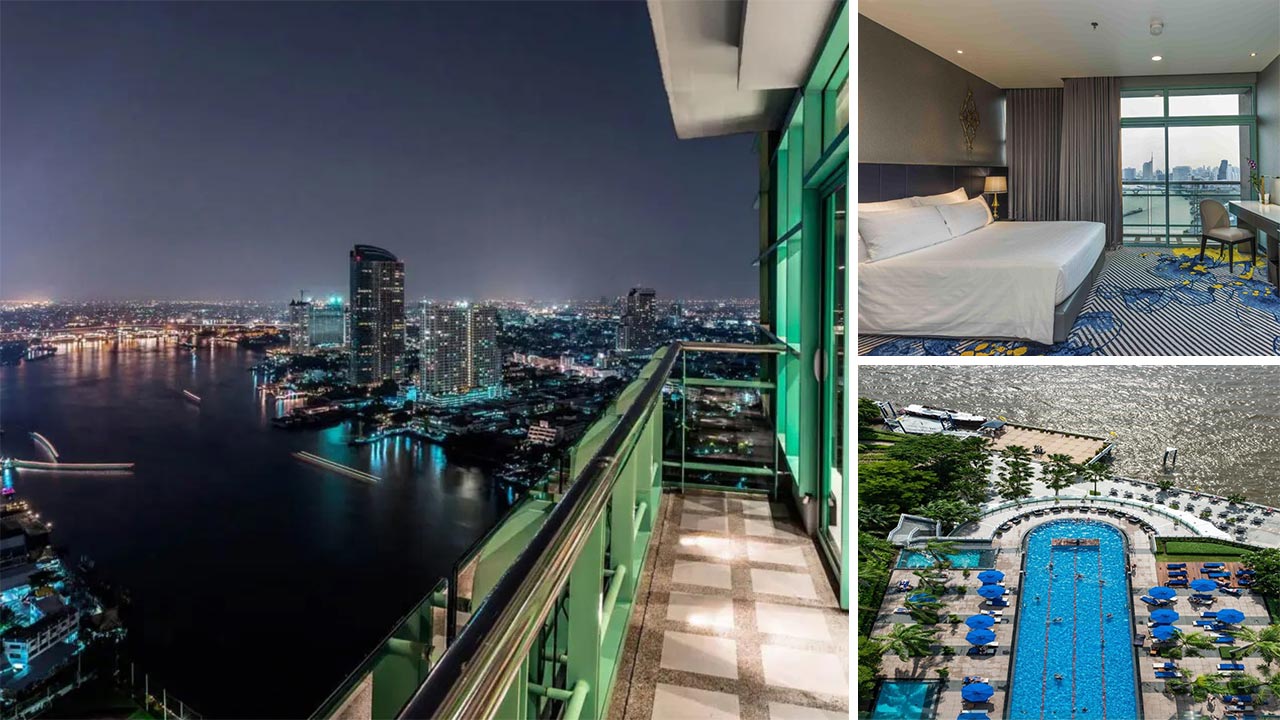
Since the hotel is a bit away from the hustle and bustle, it’s perfect for enjoying some peace and quiet. There is a complimentary shuttle boat service that takes you to Sathorn Pier, where you can catch the Chao Phraya Express Boats. Additionally, the BTS Saphan Taksin Station is also located there, providing easy access to Bangkok’s things to do.
You can find more hotels in Bangkok, including in other neighborhoods such as Sukhumvit Road, the Old Town, and Chinatown, here.
1. Wat Traimit
The Wat Traimit (Wat Traimit Withayaram Worawihan), also known as the Temple of the Golden Buddha, is located in the heart of Bangkok’s Chinatown. The temple houses the world’s largest golden Buddha statue, named Phra Phuttha Maha Suwan Patimakon. By the way, it weighs five and a half tons, stands nearly 3 meters tall, and is valued at 30 million dollars.
As a visitor, you can admire the impressive statue and learn more about the history of Buddhism in Thailand. The Buddha statue is located on the third floor, while the other two floors house a museum (Chinatown Heritage Center). It is open daily from 9:00 AM to 5:00 PM, and the admission fee is 40 Baht for the golden Buddha plus 100 Baht for the museum if you wish to explore it.
2. Sampaeng Lane
Parallel to Yaowarat Road in Chinatown, there is Soi Wanit 1, also known as Sampeng Lane. It is essentially the shopping district in the heart of Chinatown in Bangkok. One shop follows the next, while sellers push their carts filled with treats through the narrow alley, wafting the aroma towards you. It’s tight, hot, bustling, quirky, and you can truly find bargains here.
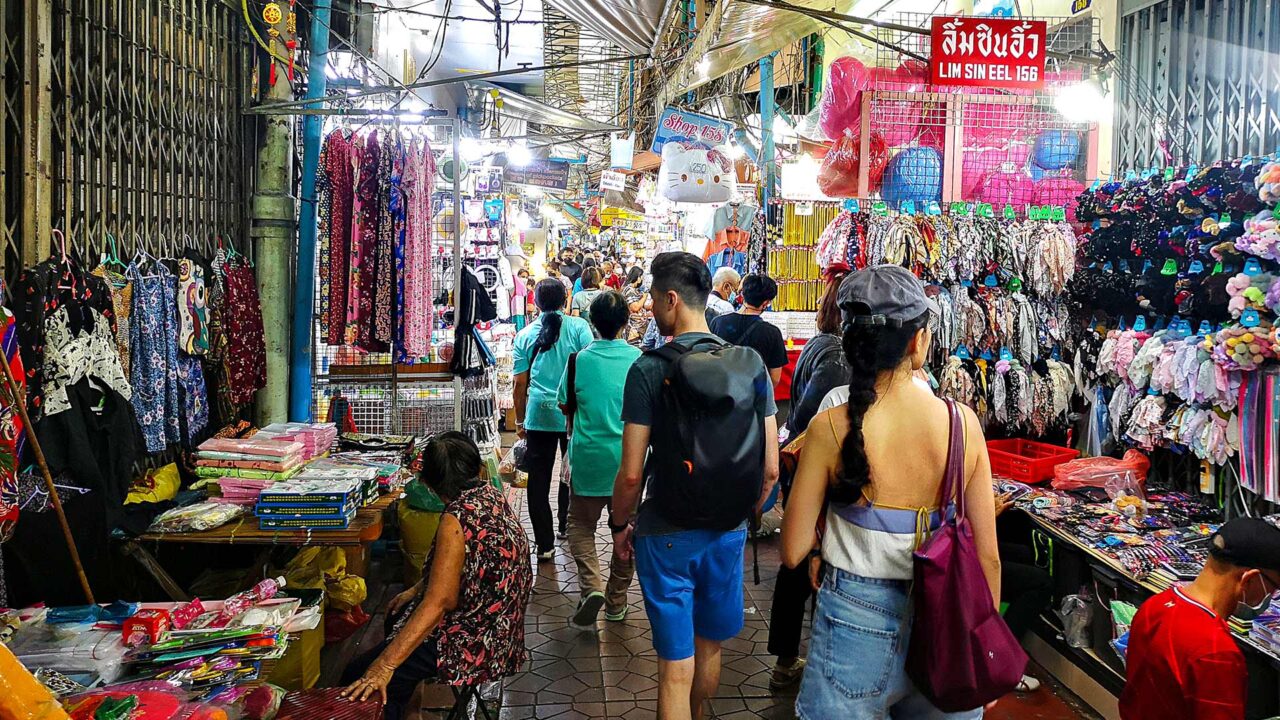
Sampaeng Lane is well-known for its wide range of affordable goods and souvenirs. Here, you can stroll through numerous shops and stalls selling everything from clothing, jewelry, accessories, household items to handicrafts and exotic foods. It is a real experience if you want to immerse yourself in the vibrant atmosphere of Chinatown.
3. Wat Chakrawatrachawat Woramahawihan
The Wat Chakrawatrachawat Woramahawihan, also known as the Crocodile Temple, is not far from Sampaeng Lane. You can reach it on foot in a few minutes. According to legend, crocodiles used to live in the Chao Phraya River, which is not far away. The gigantic crocodile named Ai-bod terrorized the people living by the river, and they hunted it. The crocodile found refuge in Wat Sam Pluem (now known as Wat Chakrawatrachawat Woramahawihan), where it continued to live under the protection of the monks. Everyone was happy, the crocodile didn’t have to die, and the people living by the river were no longer terrorized. Ai-bod’s body was stuffed after its death and can still be seen today alongside the crocodiles living there (supposedly descendants of Ai-bod) in the enclosure.
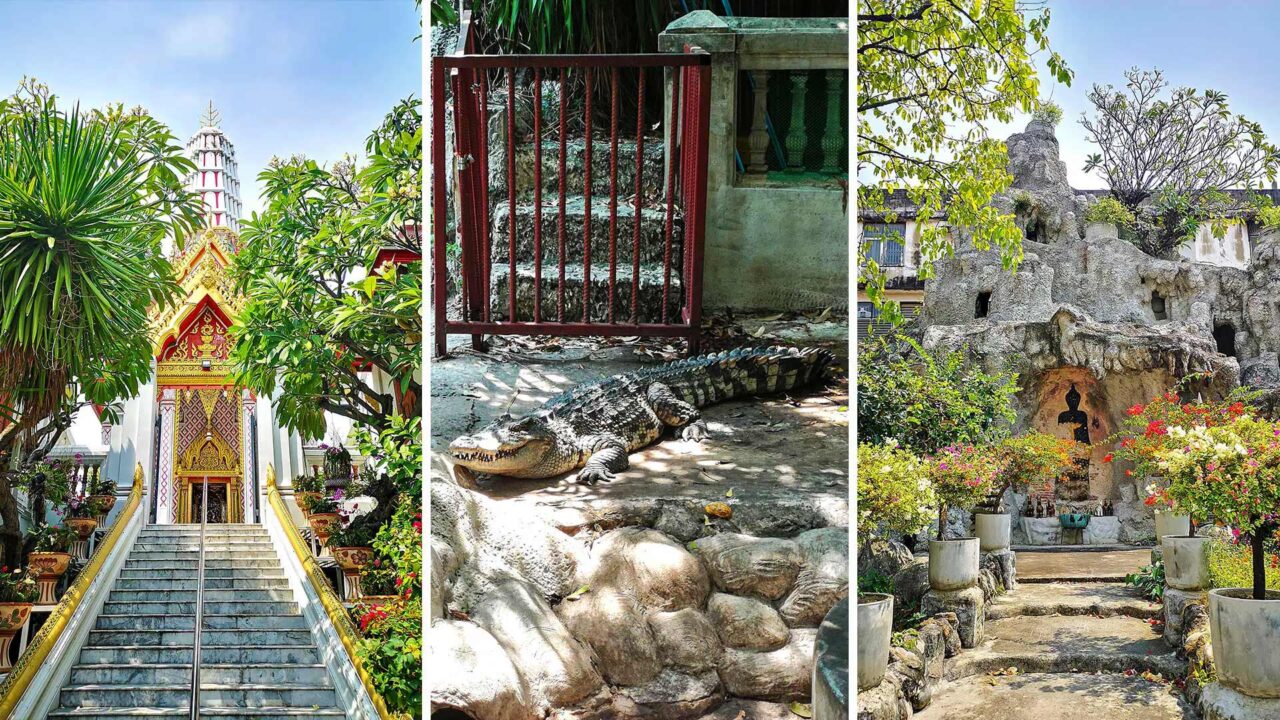
Aside from that, there are more things to explore in the temple. The Mondop and Prang, which are said to contain a relic of Buddha, as well as “Buddha’s shadow” in the cave, which is revered by visitors and adorned with gold leaf. A worthwhile visit, in our opinion, when you go to Sampaeng Lane. It’s open daily from 8:00 AM to 5:00 PM, and admission is free. If you don’t want to visit the temple alone or find it, you can also see it on a Chinatown tour, for example.
4. Chinatown Gate
The Chinatown Gate, also known as Odeon Circle, is an impressive gate that marks the entrance to Bangkok’s Chinatown. It was built in 1999 on the occasion of King Bhumibol’s 72nd birthday and is located at the roundabout near Wat Traimit. With its striking Chinese architecture and red lanterns, it is a popular spot for photos.
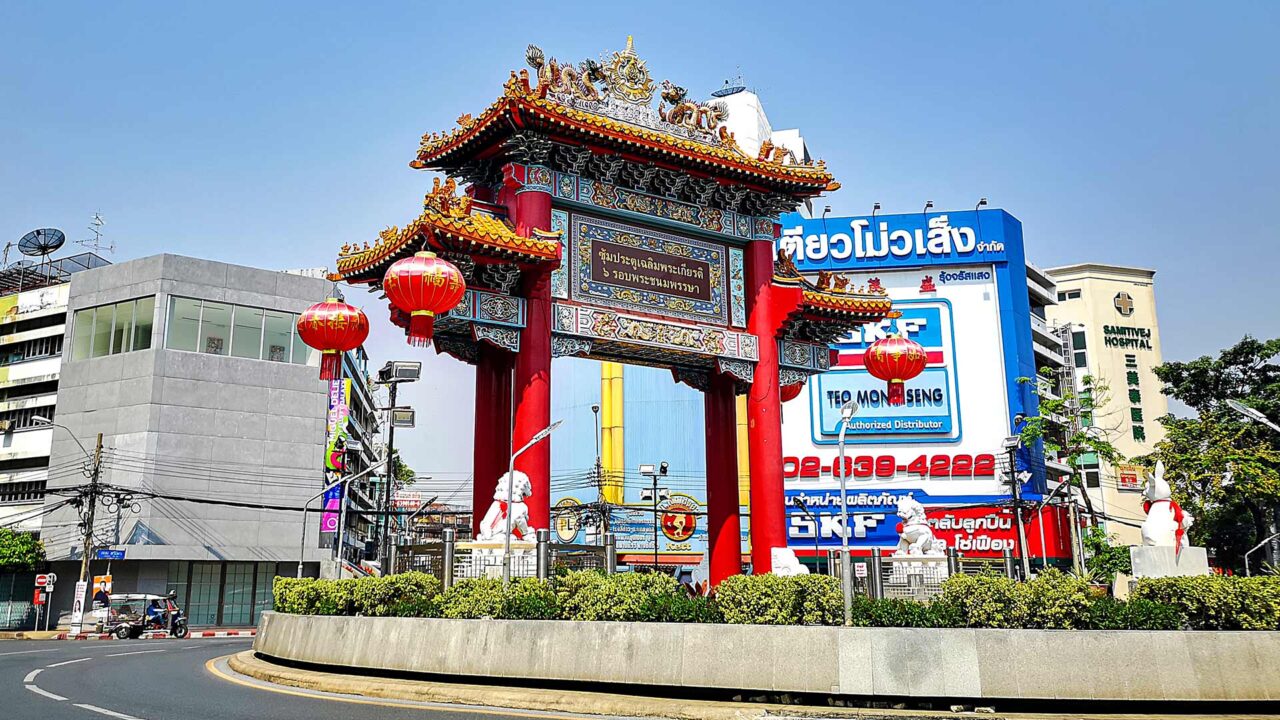
You can also use the Chinatown Gate as a point of reference. If you follow the road to the north, you’ll reach the popular Yaowarat Road, and if you go south, you’ll enter the chic Talad Noi district. During your Chinatown exploration, you’ll definitely pass by here if you’re checking out the highlights.
5. Yaowarat Road
Yaowarat Road is the main street and the heart of Bangkok’s Chinatown. This bustling street stretches for over a kilometer and is lined with a plethora of restaurants, shops (especially jewelers selling gold), and markets offering many Chinese and Thai delicacies. Here, you can enjoy delicious street food, shop for exotic spices and ingredients, or simply soak in the fascinating atmosphere of this vibrant neighborhood.
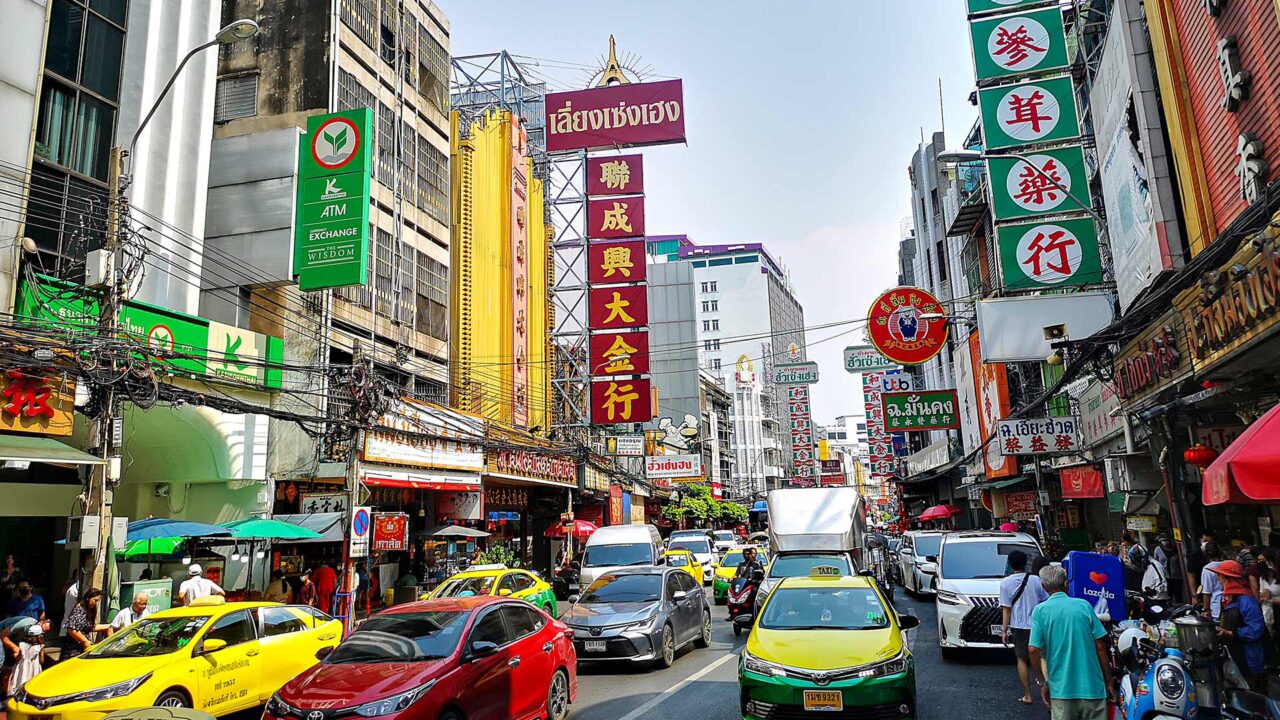
During the Chinese New Year, which is celebrated here in a particularly spectacular way, Yaowarat Road comes to life with colorful decorations and parades. But every evening, when the neon signs light up as soon as the sun sets, Yaowarat Road becomes an impressive subject for photography.
6. Sky View 360 at Grand China Hotel
The Sky View 360 Restaurant is located on the 25th floor of the Grand China Hotel. Open daily from 3:00 PM to midnight, here you can enjoy Thai fusion cuisine along with other international dishes and beverages with a breathtaking view of Bangkok. The Sky View 360 platform even rotates, but very slowly. A complete rotation takes about 2 hours, and you won’t really feel the rotation. The view during sunset is particularly beautiful, overlooking Bangkok’s skyscrapers, the bustling streets of Chinatown, and the occasional temple. However, you can also stop by, enjoy the view, and take a break from the heat of Bangkok.
7. Wat Mangkon Kamalawat
The Wat Mangkon Kamalawat, also known as the Dragon Lotus Temple, is located in the heart of Bangkok’s Chinatown. It is the largest and most important Chinese temple in Bangkok. Originally founded as Wat Leng Noei Yi in the 1870s, the temple served the introduction of Mahayana Buddhism in Bangkok and was later renamed Wat Mangkon Kamalawat by King Chulalongkorn.
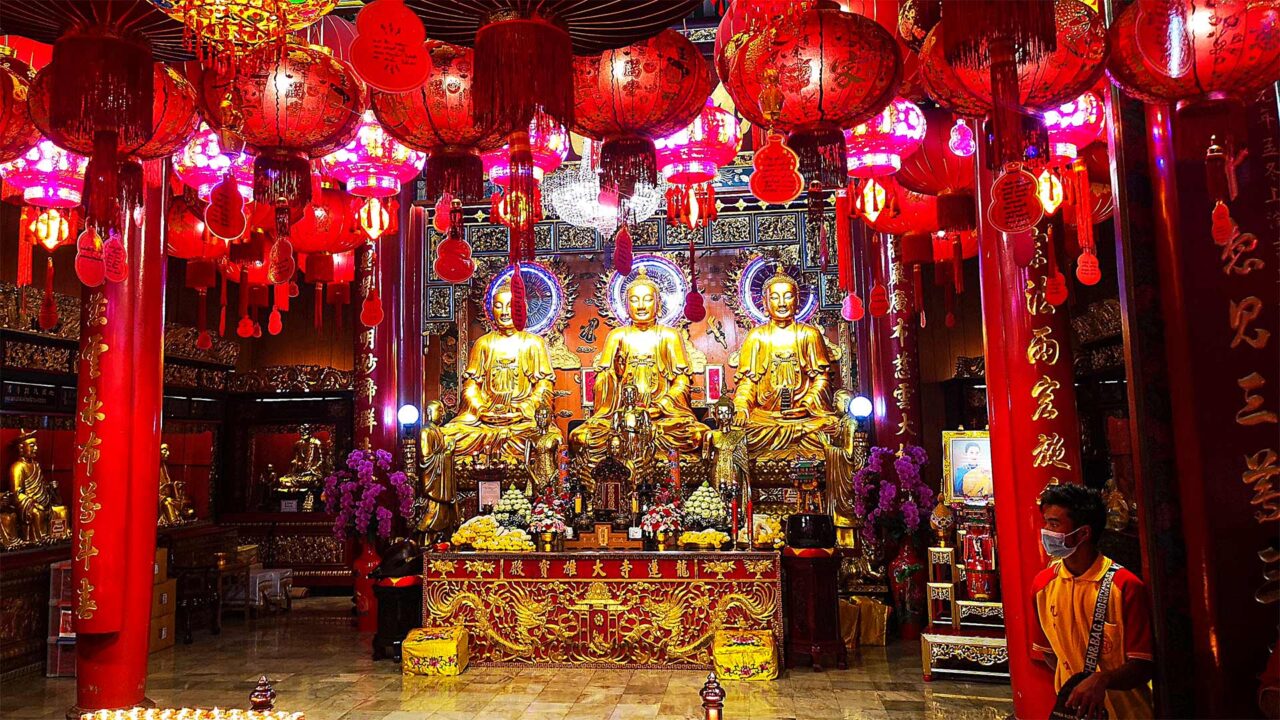
The temple is richly adorned with animal, floral, and Chinese dragon motifs and houses a golden Buddha statue in the ordination hall. Inside, you will find shrines of Buddhism, Taoism, and Confucianism, where believers constantly light incense sticks. It also serves as a venue for many Chinese events, such as the New Year’s celebration or the vegetarian festival. Admission is free, and it is open daily from 8:00 AM to 4:00 PM, or until 5:00 PM on weekends.
8. View from the River View Residence
The River View Residence is a charming accommodation, tucked away in the alleys of Chinatown, almost by the Chao Phraya River. It has just been completely renovated and has become truly beautiful. Undoubtedly, the highlight here is the rooftop terrace, from which you can enjoy a breathtaking view of the river and the surrounding buildings.
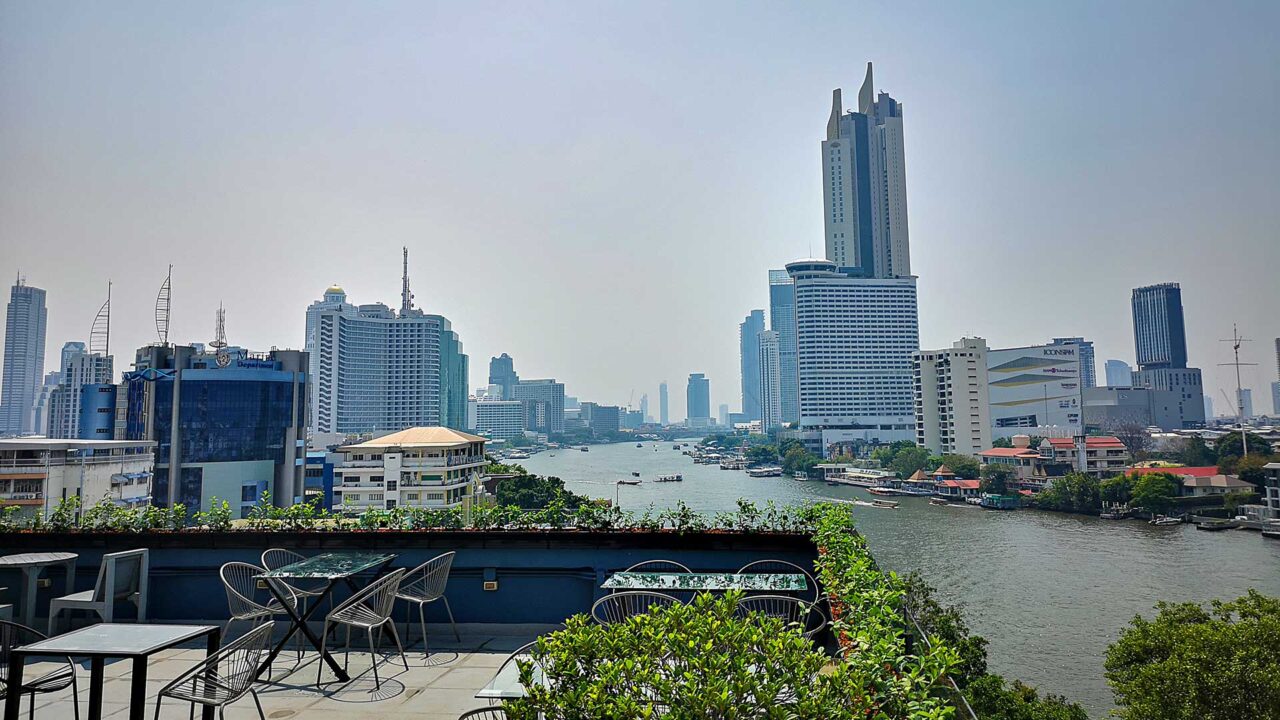
On the terrace, you will find the River Vibe Restaurant & Bar. It is open daily from 7:30 am to 10:30 pm. So, you don’t have to be a guest in the accommodation; you can simply take the elevator to the rooftop and enjoy the relaxed atmosphere. Additionally, you can savor delicious food or a refreshing drink. It’s also a great place to admire the sunset over the Chao Phraya River and watch the passing boats. A truly beautiful and relaxing spot amidst the hustle and bustle of Chinatown.
9. Talad Noi Streetart
The Talad Noi district in Bangkok’s Chinatown is known for its vibrant street art scene, where you can discover many paintings. Along the narrow alleys and old buildings of the district, you will find numerous impressive street art works created by local and international artists. These artworks range from colorful murals to striking graffiti, reflecting the creative energy of the neighborhood.
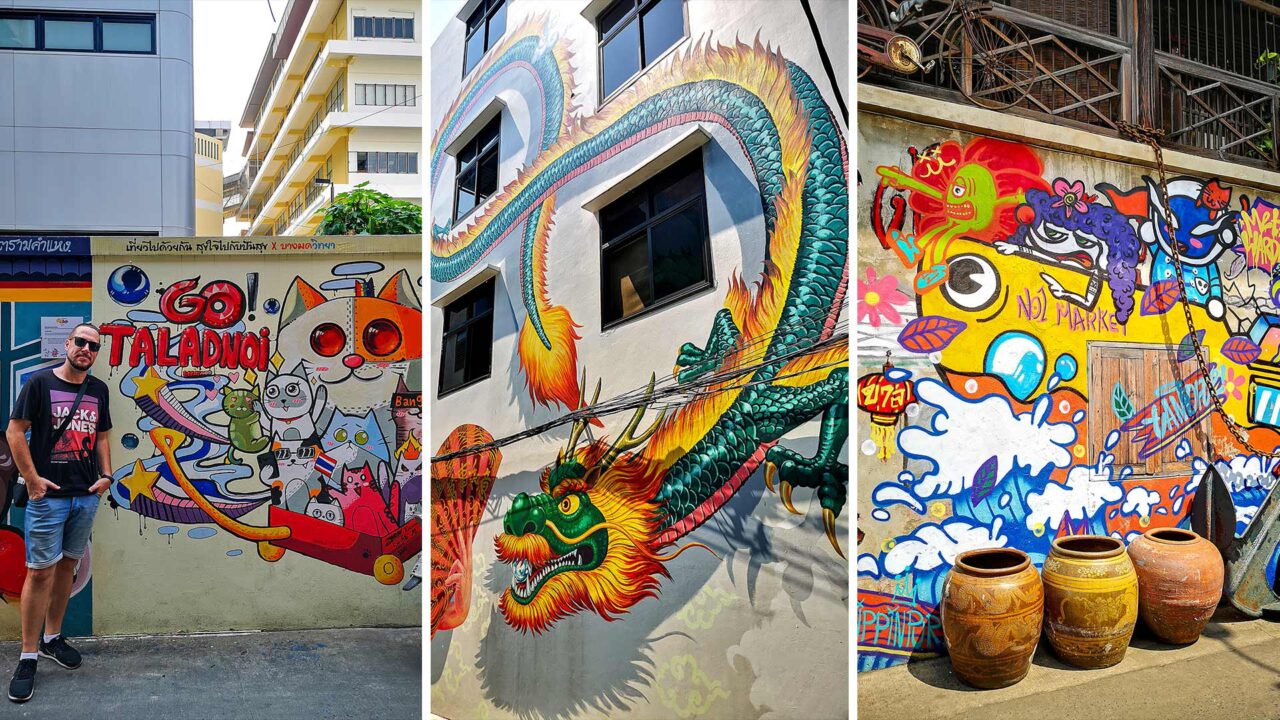
As you stroll through the Talad Noi district, you will repeatedly come across smaller and larger impressive artworks that turn the streets into an open-air gallery. Often, the street art images tell something about the history and culture of the neighborhood, giving it a unique character. Don’t miss the narrow street Trok San Chao Rong Kueak. It also leads you to the So Heng Thai Villa and the Rong Kueak Shrine, right on the Chao Phraya river.
10. So Heng Thai Villa
The So Heng Thai Villa is located in the Talad Noi district, somewhat hidden in the alleys. It was built during the 19th century and is one of the last historic Chinese houses in Bangkok. It consists of 4 houses built around a garden with a swimming pool. The latter has been a new addition since the early 2000s. The So Heng Thai Villa is privately owned but open to the public.
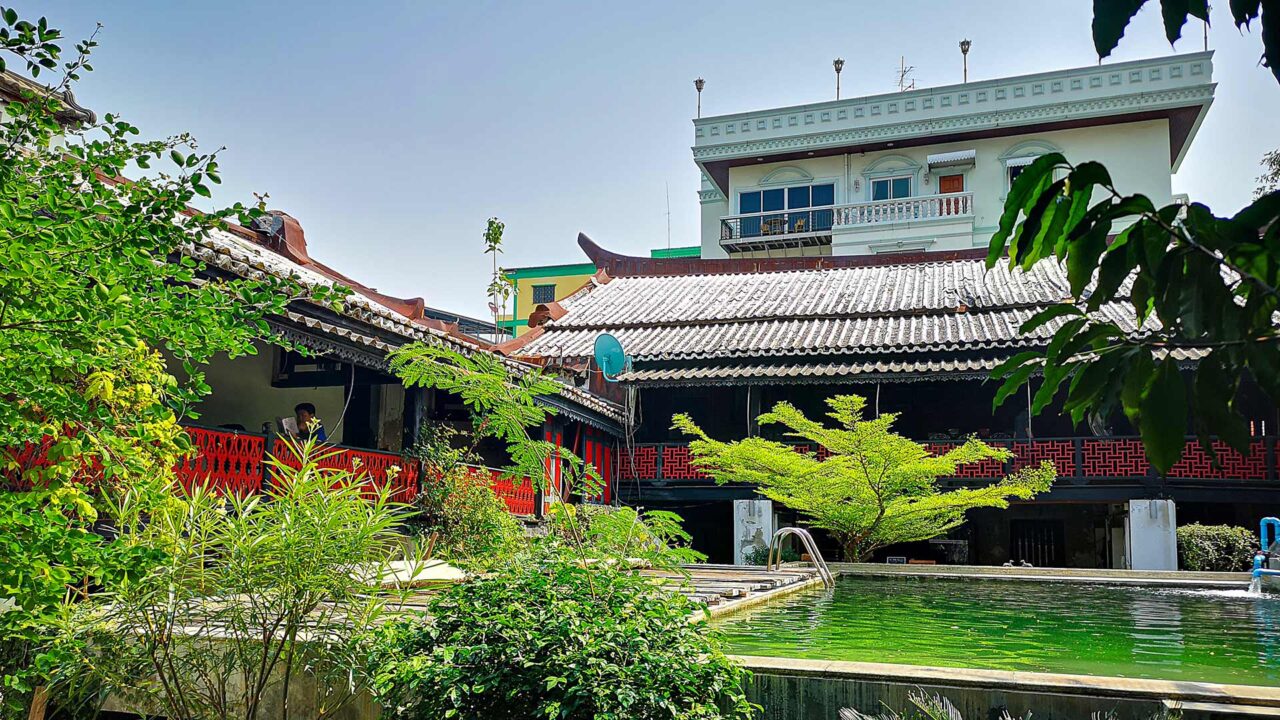
They even offer scuba diving courses in the pool sometimes. Otherwise, you can visit the truly charming villa on-site or relax with a coffee in the garden during your exploration of Chinatown. A visit should not take longer than 15 minutes, and for an entrance fee of 50 Baht, you also get a bottle of water. However, if you order a drink on-site, the entrance is free.
11. Sala Chalermkrung Royal Theatre
The Sala Chalermkrung Royal Theatre is a historic theater located in the heart of Bangkok’s Chinatown, which maintains a rich cultural tradition. It was opened in 1933 and, over the years, has hosted numerous artistic performances and shows, including traditional Thai theater, dance, and music. Originally, it was a cinema, but over time, it was replaced by more modern cinemas. Nowadays, you can enjoy traditional performances here such as Khon (masked dance drama), classical Thai dances, and music ensembles.
The theater is open daily from 9:00 AM to 6:00 PM, and you can find tickets directly on the website. However, if you visit the Royal Palace, for example, you can watch a Khon performance for free with the same ticket from Monday to Friday for 25 minutes. These performances take place at 1:00 PM, 2:30 PM, and 4:00 PM.
12. Wat Samphanthawongsaram Worawihanra
The Wat Samphanthawongsaram Worawihan, often simply called Wat Samphanthawongsaram, is a significant Buddhist temple in the heart of Chinatown. The historic temple was founded in the 18th century and holds deep cultural and spiritual importance for the local population. It is somewhat removed from the hustle and bustle of Chinatown, radiating peace and serenity.
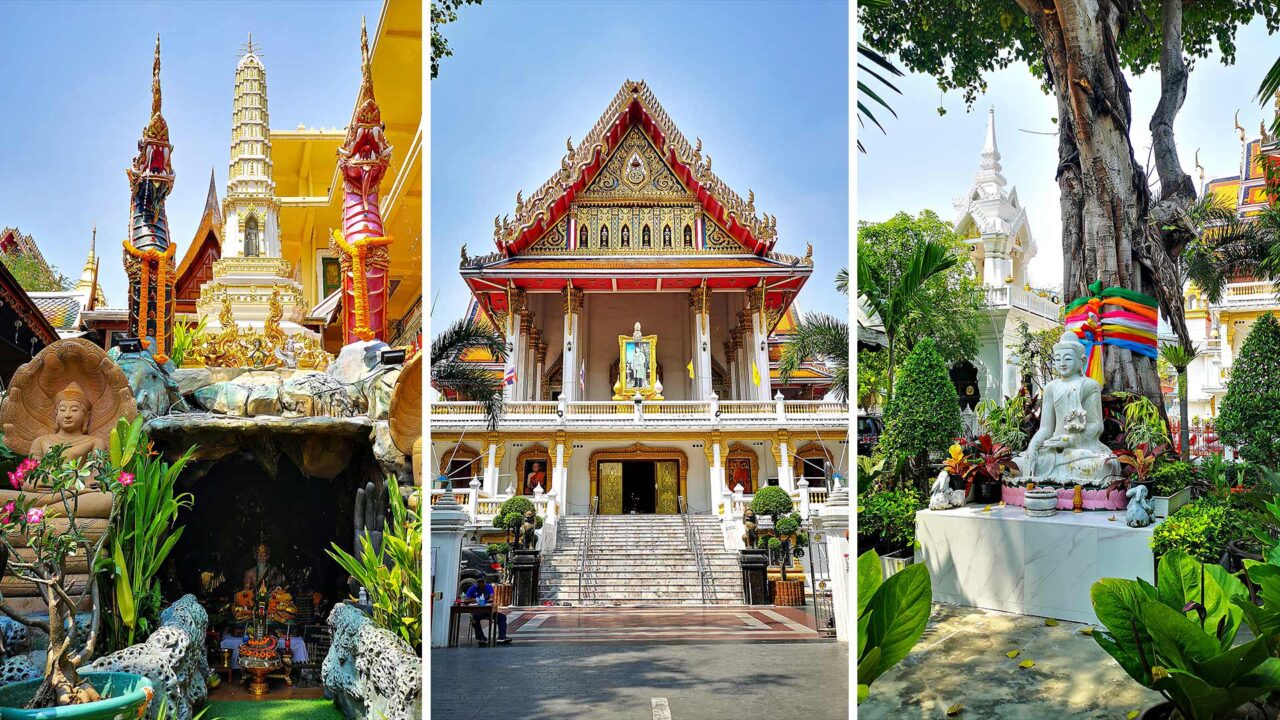
The complex offers some beautiful shrines and a highly revered Buddha statue in the Ubosot, the main temple. Particularly noteworthy are the detailed wall paintings and the gilded Buddha statues that reflect the history and culture of the temple. A brief visit is worthwhile – the entrance fee is 40 Baht for the main temple. However, you can also explore the rest of the complex for free.
13. Ong Ang Walking Street
Every Friday to Sunday from 4:00 PM to 10:00 PM, the Ong Ang Walking Street takes place. Right by the canal on both sides, there are more than 100 stalls offering delicious food from Thai, Chinese, Nepalese, Korean, or international cuisine. You can stroll along the canal, buy some food, or enjoy live music, which is also performed. If Bangkok’s Chinatown is too crowded in the evening and you’re visiting the area on the weekend, why not stop by Ong Ang Walking Street?
14. Experience Street Food in Chinatown
Chinatown and food somehow go together. So, when you wander through the colorful neighborhood, you should also try some culinary highlights. But if you don’t dare to just stop at the various stalls and try everything, we can recommend a Street Food Tour through Chinatown. Guides will take you to various alleys and stalls where you will try more than 16 different delicacies, from well-known Thai dishes like Tom Yum Goong to inspired dishes from Chinese cuisine. It is a real must-do for every foodie and food lover in Chinatown.
Plan your trip to Bangkok now
More hotel recommendations for Bangkok:
- Highlight: Chatrium Riverside
- Old Town: Navalai River Resort
- Sathorn: Eastin Grand
- Sukhumvit: The Bedrooms Boutique Hotel
Popular routes to Bangkok:
Bangkok Chinatown: Tours and Tickets
Do you prefer to travel with a guide who knows the area very well? Then we recommend a guided tour with a local. This way you can get to know Bangkok’s Chinatown in a completely different way. GetYourGuide offers a wide selection of exciting tours for Bangkok’s Chinatown.
How to Get to Bangkok
Traveling to Bangkok is relatively easy, as there are direct flights and stopovers from all the surrounding countries, as well as from Europe or the Emirates. Flights from neighboring countries arrive at Don Mueang International Airport (DMK) and flights from Europe etc. arrive at Suvarnabhumi International Airport (BKK).
Cheap flights to Bangkok can be found at Skyscanner for example. There you can compare the prices by days, see the flight duration and stopovers. Everything is very clear and absolutely recommended for a first comparison.
If you are traveling to Bangkok from other cities in Thailand or from neighboring countries such as Cambodia, then there are more possibilities. In addition to the airplane you can choose long-distance buses and trains (within Thailand) to Bangkok. Prices and times can be found at our partner 12go.asia.
Have you already visited Chinatown in Bangkok? What are your favorite attractions there? If you have more tips, please leave us a comment.

Tobi
Hi, I'm Tobi, author, passionate travel blogger and founder of this blog. I've been traveling the world a lot since 2013, mostly in Southeast Asia, but sometimes also in Europe. The Thai island of Koh Phangan has become my home base when I'm not traveling. Find out more on our About Us page.